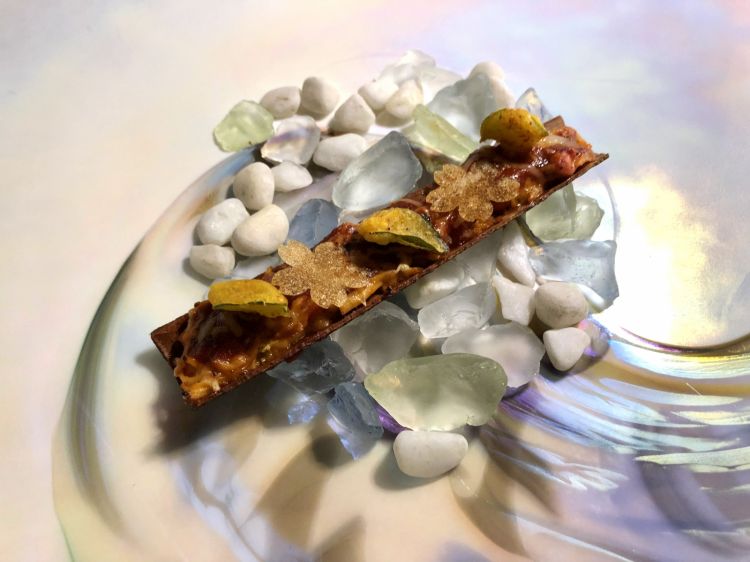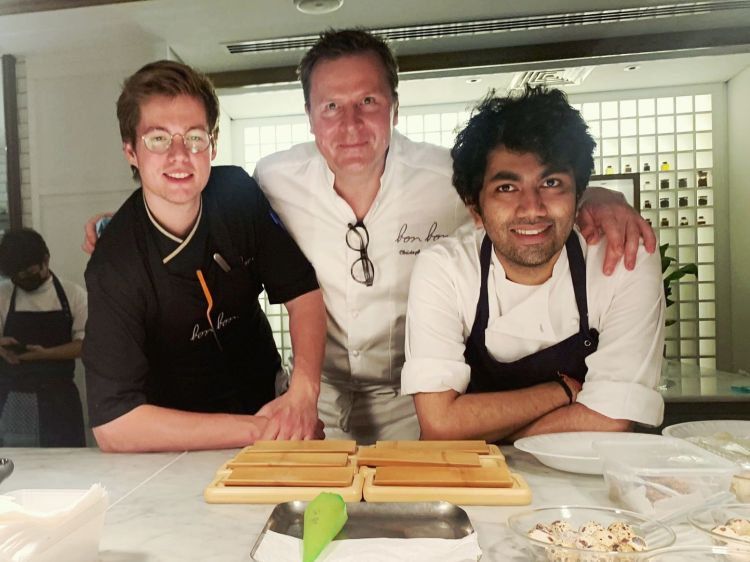According to the FAO, 40% of the 1.3 billion people who live in India are vegetarian. To this half billion one should add 400 million people who eat meat very rarely. In fact, for religious reasons (cows are sacred for Indus, and pork is untouchable for Muslims), regular omnivores in India are less than one out of three. An impressive statistic if we consider that in Italy only 7% of the population is vegetarian (a number that includes vegans too). And that in the United States vegetarians are under 4%.
Why, we wonder, in the green wave that is suddenly pervading the conscience of so many western post-covid restaurants – both fine dining and casual -, are people paying so little attention to Indian cuisine? The question comes with the scorching mist on an early summer day in Dubai. Hotel Voco is the den of one of the most interesting talents of the Subcontinent. His name is Himanshu Saini, he's 34, and has been working in the Emirates and not in his hometown Delhi or in Mumbai «because in India there are already 100'000 cooks; I didn't want to be the 100'001st. And I would also like to repay a city that has given me plenty».
How did he arrive here? Let's quickly unfold his bio. Chef Himanshu studied hospitality in school and at 21 he's in the team that starts the adventure at the Indian Accent in New Delhi, the most acclaimed establishment south of the Himalaya (he's been in the 50Best Asia every year for the past 7 years). He thus becomes sous chef, leaves and goes to work in Mumbai, at Masala Library. In 2014 he gets a surprise phone call from New York. On the other side of the phone there's an Indian restaurant near Grand Central, Manhattan: «I couldn't say no», he recalls, «Once there, however, I found out we were only 3 cooks cooking for 100 people. We made lots of frozen food and I cleaned the loos too. I was the only Indian in the team. This was the most horrible experience in my life». Luckily, I had already received an offer from Dubai: «Returning to India wasn’t even a possibility. I only had one doubt: there's no Michelin Guide in the Emirates; for a young chef this doesn’t help your curriculum. Then I thought that it would be too easy to go to France and cook in starred restaurants. I've been here 6 years and I have every intention to stay».

The food from Trèsind is also available in Mumbai and Kuwait
Now 34, Himanshu designs the food line of 3 restaurants in the Emirates' megalopolis. The first is
Carnival, a
fun dining restaurant in the financial centre. Then there's
Trèsind, on the second floor of Voco Hotel, in front of the sparkling
Museum of the Future (which is set to become the emblem of the World Fair, with its thick network of glass and steel). Trèsind is a war machine seating 200 people: well-trained waiters pull up and down the dining room scenic gueridons. At the table, they finish dishes of traditional-but-not-too-traditional Indian cuisine, and plenty of vegetarian and very pleasing bowls:
chimichurri chutney, avocado or spinach kebab, mushroom tea,
papadam ki subzi from Rajasthan (with onions)… This could already be enough to feel happy, pleased, light.
But then there's the third kitchen, which is even more interesting. It's
Trèsind Studio, a room beyond a little door hidden at the back of Trèsind. It's a pretty room seating 20 people or so, with the assembly pass in view, and cooks with pincers like at
Noma, a clear reference of the overall concept of this small restaurant. This is Himanshu's treasure chest of dreams. However, early in 2018, this seemed to him it was more of nightmare. «In the first weeks we had zero, two, three guests. I was desperate. Then a few weeks later
Massimo Bottura (who in Dubai signs
Torno Subito came to visit). He said that
Studio has many analogies with his Francescana: the ideas, the enthusiasm, the initial struggles. I will never forget it», he explains while he shows off a heart that the chef from Modena traced with some sauce left on an empty plate: «I crystallised it with resin and framed it».

A detail of the dining room at Trèsind Studio. In October 2021 it will change location: it will be at the Nakheel Mall, next to the St Regis, at the entrance of Palm in Dubai
The tasting menu at Trèsind Studio is called Spice Odissey. It's 14 steps for 495 dirham (112 euros). It's a colourful vocabulary of specialties from Punjab to Tamil Nadu, from north to south. Pani puri, khakra, ghee, rasam, chaat, poppadum… Recipes in which the incredible selection of spices plays as a substitute for salt, a builder of sapidity that gives structure and deliciousness to vegetables and sauces. Which must explode with gentle spiciness «because our food must not kill the palate of those who taste it», he says. This India made much gentler has soon created lots of uproar in town. So much so that Trèsind is ready to move in October, at the beginning of the World Fair, to a location that is up to its standards, on the roof of the Nakheel Mall, next to the St Regis, at the entrance of Palm.
A new theatre that will show a complex grammar made simple by Saini's sensitivity. A very strong vegetal character, interrupted here and there by crab cooked in clarified butter, or fragments of lamb or chicken that play more and more often a supporting role. Because the main role is taken by creamy yogurt with raw mango chutney and curry ice cream, burnt cinnamon sticks and crispy poppadam, calendula and nasturtium.
«In 10 years' time, I would like to make a 100% vegetal cuisine», he explains tracing on the horizon his crystal-clear talent. Born in Delhi and now at work in Dubai (40% of Indian population) the advantage over the West is already remarkable. Who knows if one day we'll cover that distance more than we are already doing now.
Translated by Slawka G. Scarso
The SPICE ODISSEY MENU from TRESIND STUDIO

Pani puri (fried bread, round and empty in the middle), sweet potato, lemon and toasted cumin

Shiso Khakra (a specialty from Gujarat with rice flour), creamy yogurt, raw mango chutney, herbs from the vegetable garden

Chaat millefeuilles (a specialty from Uttar Pradesh, usually made with a mix of potatoes, fried bread, mungo beans and spices, but there are many variations), courgette flower, pumpkin purée

Beetroot and lamb tartelette, nasturtium and calendula

Chilli pepper filled with pickles, marigolds and curdle ice cream with curry. Photo from Instagram

Crab toasted in ghee (traditional Indian clarified butter), burnt cinnamon, crispy potato

Tomato broth, dumpling with chicken fat, crispy coriander. Tomato is an essential ingredient in Himanshu's cuisine. The supplier? An incredible Organic Farm that thrives in the desert outside Dubai

Mousse of kebab (lamb), sour bun. Freely inspired by Massimo Bottura's La Parte Croccante della Lasagna

Rasam (a recipe from Tamil Nadu) of tomato, scampi and potato salad, chilli chutney

Confit duck leg, fermented chillies, curry with peanut butter. Photo Instagram

Sadhya pineapple (a preparation of different vegetarian snacks served on a leaf, typical of Kerala), payasam with pink pepper and coconut, mango pickle and poppadum. Photo Instagram

Inspiration milk, a mono-ingredient dish. "In a matter of few years", Himanshu explains, "India went from a country that lacked milk, to the largest producer in the world: 22.29% of global production". Photo Instagram

Cornetto of filtered coffee, chocolate ganache, miso ice cream with caramel

Right to left, Himanshu Saini at the four-handed event with Christophe Hardiquest of restaurant Bon Bon in Brussels, 2 Michelin stars. With them, to the left, the young Belgian chef Basile De Wulf of Basile in La Bruyère (photo Thomas Barker)